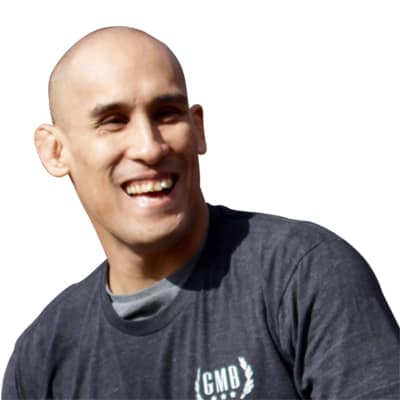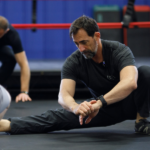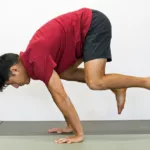Yoga—especially the many styles of Hatha yoga—is one of the most widely practiced forms of bodyweight-based movement.
So it’s no surprise we often get comments from folks with a yoga background saying, “That looks like this pose,” or even, “Aren’t you doing that wrong?”
Totally fair.
A lot of the movements we teach might look familiar if you’ve spent time in a yoga studio. But while some of the shapes may overlap, what we’re doing—and why we’re doing it—comes from a different place.
What is Yoga, Anyway?
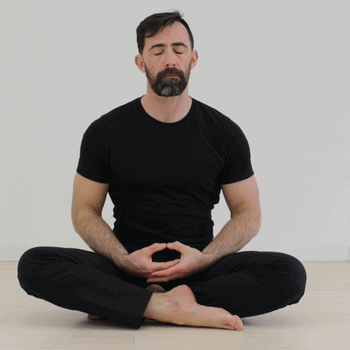
Let’s get something out of the way: “Yoga” can mean wildly different things depending on who you ask.
- To some, it’s a full-on spiritual practice with postures supporting meditation and inner work.
- For others, it’s a sweaty flow class at the gym.
- Some teach it as therapeutic movement. Others as performance art. Some as calisthenic-style exercise.
And all of that is valid.
Practice and performance are very dependent upon the style of yoga being taught. The most popular forms are Iyengar static postures, Vinyasa style, which incorporates shorter holds and movement in between poses, and hot yoga, which usually involves a pre-set sequence of postures performed in a hot room.
The reality is, yoga has evolved into a catch-all term. There are thousands of teachers, dozens of styles, and philosophies, each with their own traditions and techniques. That’s why saying something is “right” or “wrong” based on yoga alone doesn’t make much sense—it really depends on the context, the teacher, and the intent behind the movement.
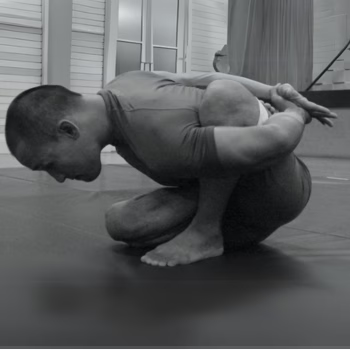 Performance and technique details in yoga can be anatomy and kinesiologically based, and/or as a matter of “tradition.” This can be controversial even within yoga systems themselves.
Performance and technique details in yoga can be anatomy and kinesiologically based, and/or as a matter of “tradition.” This can be controversial even within yoga systems themselves.
Plus, as much as it’s true that yoga has been practiced for thousands of years, no movement or position was “invented” by yoga. There is a lot of overlap of exercises across different bodyweight modalities.
So, How Does Yoga Compare to GMB?
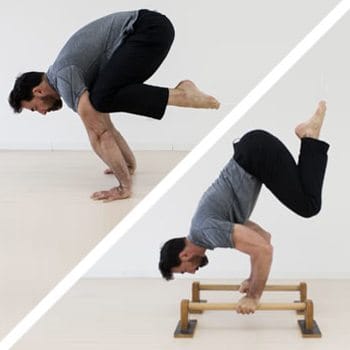 At GMB, we’re not teaching yoga, though I and Ryan, — have formal backgrounds in it. (I studied Ashtanga yoga under Cathy Louise Broda and Ryan completed a 200-hour Hatha yoga certification in Japan over 20 years ago).
At GMB, we’re not teaching yoga, though I and Ryan, — have formal backgrounds in it. (I studied Ashtanga yoga under Cathy Louise Broda and Ryan completed a 200-hour Hatha yoga certification in Japan over 20 years ago).
But our programs pull from a much broader mix: gymnastics, martial arts, physical therapy, and real-world coaching experience with over 125,000 clients.
The goal? Practical physical autonomy. We want you to build strength, mobility, and control so you can do what you want with your body—whether that’s a deeper squat, smoother jiujitsu, or just getting up off the floor without pain.
Intent and Details Make the Difference
And there’s one more thing worth calling out—something we don’t talk about nearly enough: GMB is culturally agnostic. That means we don’t align ourselves with any specific discipline or spiritual lineage. While we’ve drawn inspiration from many traditions—including yoga—we’ve intentionally stripped away the cultural or philosophical framing that can sometimes feel like baggage.
Why? Because we want our programs to be usable by anyone, anywhere, regardless of their background or beliefs. The goal is practical: build strength, control, and capability. Full stop.
What most people don’t know is that, before GMB even existed, we created a yoga course that was used by thousands of people. So we’re not outsiders looking in—we made a conscious decision to do something different. That’s because we’re not tied to any lineage or belief system. We acknowledge our history and honor our learning but our method has been purposefully decontextualized.
You can hear more about that choice —and our experience with yoga— on this podcast episode about our origins.
The Same Shapes Can Mean Very Different Things
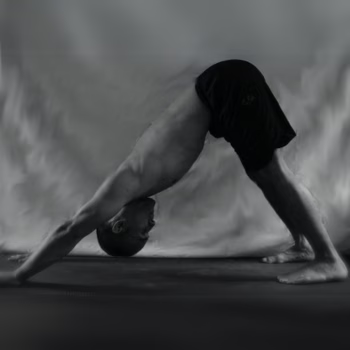 When you first see an A-Frame in GMB training, it may remind you of yoga’s Downward Facing Dog. At first glance, it’s the same shape: hips lifted, arms straight, chest open.
When you first see an A-Frame in GMB training, it may remind you of yoga’s Downward Facing Dog. At first glance, it’s the same shape: hips lifted, arms straight, chest open.
But, just like a lot of things, there’s a lot more than what you see at first glance.
The similarity stops at the surface.
For us, The A-Frame is used as a dynamic checkpoint. It’s assessment and preparation tool that helps show you where you are in the moment. So with this the cues we use to teach the A-Frame emphasize what we want our clients to accomplish;
- Active scapular elevation
- Controlled shoulder positioning
- Coordinated pressure through all four limbs
All of which which build stability and readiness for more complex movements. Because when your strength matches your flexibility, you move with more freedom—and less fear of strain and injury.
The Downward Facing Dog is often held statically for relatively long periods as an adjunct to breath control (bandha work). Which is great! If that’s what you’re after. Remember it depends on your goal.
And different goals require different intents, cueing, and performance.
Some of the shapes may look familiar to yoga. But we teach them differently, emphasize different attributes, and prioritize performance outcomes in everyday life. So instead of saying “this is like yoga,” it’s more accurate to say: “This might look familiar if you’ve done yoga, but we’re aiming for something different.”
Form vs. Function: Why We Use Certain Shapes
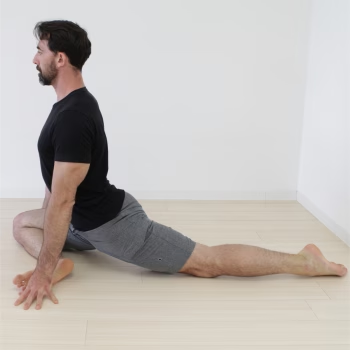 You’ll also notice other familiar shapes scattered throughout GMB programs—Pigeon, Cobra, Camel, and more. And it’s natural to assume we’re borrowing from yoga.
You’ll also notice other familiar shapes scattered throughout GMB programs—Pigeon, Cobra, Camel, and more. And it’s natural to assume we’re borrowing from yoga.
But again, the intent and details make all the difference.
We don’t select these shapes because of their tradition or appearance. We use them because they are functionally powerful positions for training real attributes:
- The Pigeon is more than a “deep hip stretch” for its own sake—we focus on hip rotation control and preparing the hips to move well in deep squats and lunges.
- The Cobra isn’t aimed at “opening your heart”—it’s a deliberate spinal extension drill aimed at bringing awareness to your upper back mobility and how it affects your movement.
- The Camel is more than an elegant backbend—it’s active mobility into that extension under tension. An incredibly valuable skill!
In yoga, how you use these poses depends heavily on the tradition, philosophy, and teacher. In GMB, we strip away lineage and symbolism and focus on what the movement does for your body today.
This isn’t a knock on yoga. If yoga is working for you, great—keep going!
We simply offer a different lens: movement as functional skill, not static expression.
| GMB Programs | Yoga | |
|---|---|---|
| Type | • Movement and skill-based | • Variable--Static postures or Movement based if Vinyasa style |
| Delivery System | • Our web app Praxis you can use on your phone or stream from your computer, tablet, or smart TV. | • Primarily group classes • Follow-along class style in DVD or online product |
| Cost | • From $39 to $150 | • $15-$20 per in-person class • Variable for DVD or online products |
| Client Support | • Email • Alpha Posse member forum (paid) | • Variable depending on provider |
| Audience | • Beginner to Advanced | • Beginner to Advanced |
| Format | • Step-by-step daily programming | • Variable depending on the provider |
| Plan | • Programmed each day for the length of the program | • Variable depending on the provider |
As you can see, there are so many variables with yoga that are unknown because it fully depends on the teacher, style, and setting at hand. But if you are interested in yoga, just be sure to do some research on the different styles being offered in your area and be prepared to try out some different teachers to make sure you find someone you’re comfortable with.
You don’t have to choose between yoga and GMB. In fact, many of our clients and trainers practice both. They complement each other well, especially when your goals are around freedom of movement and feeling good in your body.
Here’s how GMB can support your yoga practice:
- Elements – A great place to start if you want to get stronger overall along with gaining more mobile hips and shoulders. It’s low-pressure, flexible, and builds a baseline of body control that translates to better alignment and stability in yoga.
- Mobility – If you’ve hit a wall in specific poses—tight shoulders in Downward Facing Dog, cranky hips in Pigeon—our targeted mobility program helps you address those restrictions with practical, active techniques. Not just stretching, but teaching your body how to move with control.
Training to move and feel better shouldn’t mean picking sides—or defending a tradition. It should meet you where you are, and support your needs, your body, and your life.
If you’re already practicing yoga and you love it, we would never tell you to stop! By the same token, if you’ve tried it and it didn’t really click for you, why should you force yourself to do it? If you want to build more strength and control, reduce pain, or feel more confident in how your body moves—GMB can help.
And if you’re blending both approaches? Even better. We’re here for that.
Build a consistent movement practice focused on the basics: strength, flexibility, and control—on your terms, at your pace. No studio required. No dogma attached. Just solid movement for real life.
Ready when you are!👇
Build a Consistent Movement Practice With a Foundation in the Basics
With Elements, you’ll build a foundation of strength, flexibility, and control working at your own pace, setting yourself up for a successful lifetime of staying fit and active.


